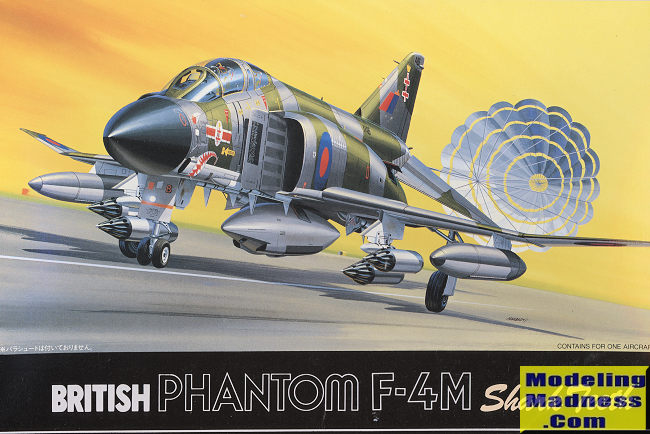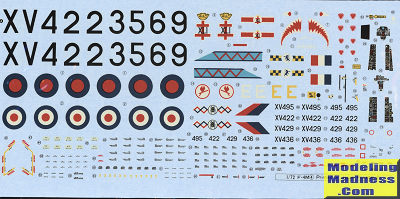
Fujimi 1/72 F-4M Phantom II
| KIT #: | 7AH9 |
| PRICE: | $ |
| DECALS: | Four options |
| REVIEWER: | Scott Van Aken |
| NOTES: | 1987 release |

| HISTORY |
The United Kingdom operated the McDonnell Douglas F-4 Phantom II as one of its principal combat aircraft from 1968 to 1992. The UK was the first export customer for the Phantom, which was ordered in the context of political and economic difficulties around British designs for the roles that it eventually undertook. The Phantom was procured to serve in both the Royal Navy's Fleet Air Arm (FAA) and the Royal Air Force in several roles including air defence, close air support, low-level strike and tactical reconnaissance.
Although assembled in the United States, the UK's early Phantoms were a special batch built separately with a significant amount of British technology as a means of easing the pressure on the domestic aerospace industry in the wake of major project cancellations. Two variants were initially built for the UK: the F-4K variant was designed from the outset as an air defence interceptor to be operated by the FAA from the Royal Navy's aircraft carriers, and the F-4M version was procured for the RAF to serve in the tactical strike and reconnaissance roles. In the mid-1980s, a third Phantom variant was obtained when 15 second-hand F-4J aircraft were purchased to augment the UK's air defences following the Falklands War.
The Phantom entered service with both the FAA and the RAF in 1969. In FAA service, it had a secondary strike role, while in the RAF it was soon replaced in the strike role by other aircraft designed specifically for strike and close air support. By the mid-1970s, the Phantom had become the UK's principal interceptor, a role in which it continued until the early 1990s.
| THE KIT |
 In 1987, Fujimi released their British F-4s, providing kits of
the F-4K, F-4M, FG.1 and FG.2. The latter two are distinguished by the rectangular
antenna housing atop the fin. Prior to this, there were not any accurate British
F-4s in this scale. Both Revell and Hasegawa simply added RAF style burner cans
to existing kits while the Matchbox offering had a number of shape issues.
Fujimi, however, did their homework and not only incorporated the correct burner
cans, but enlarged the fuselage to deal with the larger Spey engines used in the
RAF's Phantoms. This engine made it the fastest accelerating and slowest of the
Phantom II family.
In 1987, Fujimi released their British F-4s, providing kits of
the F-4K, F-4M, FG.1 and FG.2. The latter two are distinguished by the rectangular
antenna housing atop the fin. Prior to this, there were not any accurate British
F-4s in this scale. Both Revell and Hasegawa simply added RAF style burner cans
to existing kits while the Matchbox offering had a number of shape issues.
Fujimi, however, did their homework and not only incorporated the correct burner
cans, but enlarged the fuselage to deal with the larger Spey engines used in the
RAF's Phantoms. This engine made it the fastest accelerating and slowest of the
Phantom II family.
The kit offers a fairly nice cockpit with the proper seat accoutrements. Like Navy F-4s, there were no flight controls in the back seat and unlike some other kits, this is properly reproduced in the cockpit tub. Four piece bang seats are adequate and the instrument panels and consoles use decals, which is fine for this scale.
Typical of most 1/72 F-4 kits the intake trunking is abbreviated and about an inch deep. The F-4K/M has auxiliary engine intake doors on the aft fuselage and these have been duplicated. You can pose them open or closed. Wings are a lower poice and two upper halves. Fujimi gives you the option of opening holes for the centerline tank and wing pylons. Most F-4s at least carried wing pylons. The lower forward fuselage contains the nose gear well and is a separate piece. This should be attached along with the wing to ensure a good fit.
Fujimi offers a single piece canopy along with the option for
the multi-section version. Landing gear are nicely done and look very good. The
main gear doors are a single piece and must be cut for lowered gear. There are a
pair of inserts for where the launching strap attaches on the F-4K. For things
under wings/fuselage you have a centerline and wing tanks, a photo
reconnaissance pod, a gun pod, a pair of rock et pods for the inner wing pylons,
Sparrow missiles and a strike camera. No Sidewinders as this variant was a
dedicated strike platform.
et pods for the inner wing pylons,
Sparrow missiles and a strike camera. No Sidewinders as this variant was a
dedicated strike platform.
Instructions are well done and provide Gunze paint references. All four options are in dark green/dark grey over light grey. There are a variety of insignia differences depending on which marking option you choose. You get planes from 41 Sq, 54 Sq, 6 Sq, and 226 OCU. The decals themselves are nicely printed, but I think the red is too bright. Aftermarket decals are not at all difficult to locate.
| CONCLUSIONS |
Before the release of the Airfix FG.1 last year or so, these were the best British Phantoms in this scale. Many still prefer them as they build well and are devoid of the fiddly stuff you get with the Airfix kit.
| REFERENCES |
https://en.wikipedia.org/wiki/McDonnell_Douglas_Phantom_in_UK_service
April 2021 Copyright ModelingMadness.com. All rights reserved. If you would like your product reviewed fairly and fairly quickly, please
contact
the editor or see other details in the
Note to
Contributors.